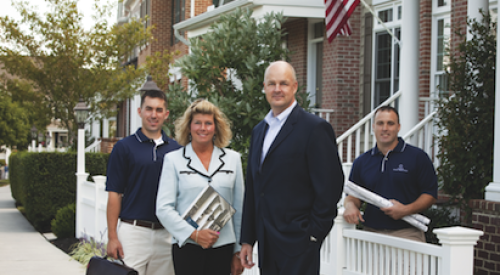As simple as it seems, continuous improvement baffles me. Not because it's hard to understand; I'm baffled that such a simple concept can create so many different interpretations. Maybe it's too simple.
In "The Other Ninety Percent," author Robert Cooper explains continuous improvement by comparing the difference between those that compete and those that excel.
"To compete means to run in the same race, in the same way as everyone else...always knowing that someone must lose for you to win. Your goal is to get across the finish line first by any 'fair' means."
"To excel means to continually reach beyond the best you have ever given because doing so matters to you personally. It means that you're continuously trying to be better than your yesterday's self."
While competing and excelling might seem like they go hand-in-hand, there's a huge difference. If you're competing, you're always trying to figure a way get a leg up on the competition. In the end, you'll only be as good as your competition allows you to be.
If you're working to excel, you've changed the rules. With innovation, your creativity will be limitless. You'll soon become the leader instead of a participant in the race. In the end, your competition will always be chasing you and will never quite be able to figure out why they can't catch up. Let me share a story and you'll see what I mean.
That's Impossible!
Not too long ago I was invited to participate with a Ohio builder in one of its forward planning meetings. The company's goal was simple: it wanted to create a breakthrough strategy or plan that would revolutionize its current sales program.
I was dumfounded when I heard what the company wanted to do. I sat there thinking to myself, "It might be easy for some companies, but how in the world could this company achieve such goals?"
I didn't think as much about if they could do it, rather I was more concerned about whether it was possible. I had six or seven years worth of proof that made me feel this way. The builder's current program already produced numbers that would rank it in the top two to three percent of all the sales teams in the country. How could it get better?
It didn't take me long to change my mind. The more we worked, the more I felt my excitement rise. I quickly realized I was dealing with people that were interested in excelling, not competing. These were people that wanted to take the best program in Ohio and make it better. The more we talked, the more I realized we were paralleling a process I had once read about in a book that was simply titled "Jack."
Improving on the best
Jack Welch, former chairman and chief executive officer of GE, believes in simple. If it isn't easy to understand and it isn't easy to execute, then it isn't worth it. His program to develop a competitive strategy was no different. Managers at GE knew it as The Three Step Process. Like Welch's three step process, the builder's process went something like this:
- Step One. Come up with an "aha!" idea. Come up with a new idea or borrow an idea and revolutionize it.
- Step Two. Make sure there are people in place that will be able to execute the "aha!" idea. People resources are critical and paramount if a builder is going excel rather than compete.
- Step Three. Create a set of metrics to measure key program points. Work every day, every month and every year to continually improve performance.
The whole meeting just seemed so smooth. We began with an "aha!" idea which was transformed into an outline of specific program points. Once completed, we discussed people resources as they related to our program outline. Finally, we concluded with a debate about metrics, measurement and continuous improvement.
I was amazed by this company's desire to excel. But as amazing as they seemed, it's not that way with everyone.
Selling in Lake Wobegon
Harry Beckwith, author of "Selling the Invisible: A Field Guide to Modern Marketing," addresses continuous improvement from a different perspective. Beckwith takes the backdoor, pointing to recent research that suggests the average American believes he is smarter, better looking and better at his job than he really is.
This belief is so prevalent psychologists have come up with a name for it: the Lake Wobegon Effect. The name comes from Garrison Keillor's famous radio show sign-off from his fictional hometown, Lake Wobegon, "Where the women are strong, the men are good-looking and all of the children are above average."
I don't know about you, but I personally believe there's a Lake Wobegon in the building industry — "Where the profits are strong, the plans are pretty and all of the sales associates are above average." Maybe the profit part is a bit much, but pretty plans and above average sales associates is right on target. Think about it.
What sales and marketing manager doesn't think he has the prettiest plans and the best sales program in his competitive market area? It's the Lake Wobegon Effect in action. When builders start competing rather than excelling, continuous improvement becomes an afterthought.
Revolutionize Your Sales Program
"Good is the enemy of great" says Jim Collins, author of "Good to Great." His book goes on to say if companies are comfortable with being good, it's hard for them to be motivated to do much more. Collins also says the comfort level [with being good] is so subtle most people don't even realize they've been seduced into thinking this way, it just happens.
Would you like to go from good to great every year? I've chosen an "aha!" idea: your sales program.
Consider the following plan:
- Step One. You need to start with a universal truth: behaviors drive your sales process and your sales process drives your customer's experience. Manage for behaviors, not results.
- Step Two. In this critical step, you'll want to divide your customer's shopping/decision process into a roadmap. Define two or three decisions every customer must make before they make their final buying decision. Using your current sales process, match selling to deciding. Determine which sales behaviors or techniques would create a win/win situation at each of your customer's various decision points. Let each sales behavior or technique define your new process. Remember, you may have to design a few new techniques to match the different decisions your customers will make prior to their final decision.
- Step Three. Design and administer a baseline test to measure your associate's knowledge prior to your program kickoff. Assess whether your associates can explain their objectives (Level I) or role-play their sales objectives (Level II) as they relate to their customer's decision process. You'll measure future progress against this score.
Use a large group meeting to kick off the program. Follow up each month with small group meetings. Use these meetings to discuss and practice specific sales behaviors. Choose one behavior per month and allow associates to move to the next month's behavior when they are successfully able to:
- Level I Performance: Freely discuss their objective and why it's important
- Level II Performance: Role-play the behavior needed to accomplish their objective
Continuous improvement requires measuring the result that each behavior produces and working to improve it.












